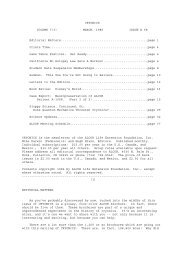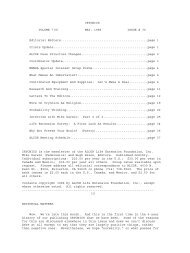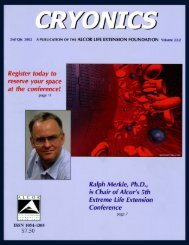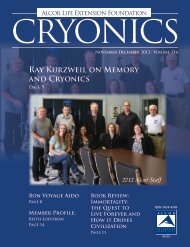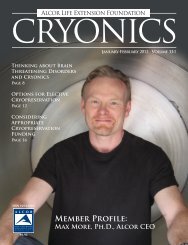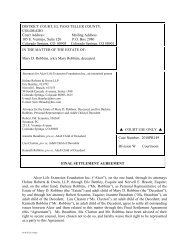Download PDF - Alcor Life Extension Foundation
Download PDF - Alcor Life Extension Foundation
Download PDF - Alcor Life Extension Foundation
Create successful ePaper yourself
Turn your PDF publications into a flip-book with our unique Google optimized e-Paper software.
Frozen (left) and vitrified (right) rabbit kidneys immersed in glassy cylinders of the perfusate used to perfuse<br />
the kidney on the right. The kidneys were photographed at minus 140 degrees Celsius after removing the<br />
containers in which they were originally cooled.<br />
bone marrow cells and red blood cells, but also<br />
included a paper by a cryosurgeon using freezing<br />
and thawing as a way of deliberately destroying<br />
living tissue.<br />
Cryobiologists have been able to successfully<br />
preserve the viability of most of the cells in the<br />
human body in isolation by freezing, and it<br />
is also possible to preserve simple tissues and<br />
sometimes not-so-simple tissues using relatively<br />
unsophisticated freezing techniques. But when<br />
the system becomes thick enough to require<br />
support by a blood supply immediately after<br />
thawing and transplantation, the deficiencies<br />
of freezing become more obvious in part<br />
because damage to blood vessels begins to be a<br />
problem.<br />
Despite vascular damage caused by the<br />
development of rock-like grains of ice in living<br />
tissues, amazing feats have been attained,<br />
including the survival of a minority of segments<br />
of dog small intestine after freezing in liquid<br />
nitrogen and subsequent transplantation [4], and<br />
even the recovery of hamsters after superficial<br />
whole body freezing [5]. Nevertheless, most<br />
cryobiologists are coming around to the point<br />
of view that if one wants to be able to bank<br />
most whole organs and “bring them back alive”<br />
in a truly satisfactory state of health, the old<br />
freezing paradigm is not the way to go.<br />
Instead, vitrification, which literally<br />
means “glass formation,” is an approach to<br />
cryopreservation that can theoretically preserve<br />
living systems of arbitrary complexity and size<br />
because of its ability to eliminate the physical<br />
injury to blood vessels and other structures<br />
caused by the development of ice crystals<br />
that can push against these structures and<br />
literally tear them at least partially apart. The<br />
photograph (modified from [6]) shows that<br />
vitrification can be accomplished on the size<br />
scale of rabbit kidneys (about 10 milliliters),<br />
and the vitrification of volumes up to 2<br />
liters has also recently been experimentally<br />
demonstrated [7].<br />
Ice formation can develop forces strong<br />
enough to split open rocks, so it is logical that<br />
preventing freezing by using vitrification is<br />
developing into a safer way to approach the<br />
problem of whole organ cryopreservation [8].<br />
But that is a topic for another time.<br />
References<br />
1. Parkes, A.S., Cryobiology. Cryobiology 1<br />
(1964) 3.<br />
8 Cryonics/Spring 2006<br />
Dr. Fahy received his Ph.D. in 1977<br />
at the Department of Pharmacology<br />
at the Medical College of Georgia,<br />
specializing in mechanisms of freezing<br />
injury in cells and tissues and in the<br />
pursuit of alternatives to freezing. He<br />
joined the American National Red<br />
Cross in 1977, and in 1980 conceived<br />
of the idea of vitrifying whole organs<br />
as a solution to the problems created<br />
by ice formation. He has pursued<br />
this concept to the present day and<br />
is now the Chief Scientific Officer of<br />
21 st Century Medicine, a company<br />
dedicated to solving the most difficult<br />
problems of applied cryobiology.<br />
2. Polge, C., A.U. Smith, and A.S. Parkes, Revival<br />
of spermatozoa after vitrification and dehydration<br />
at low temperatures. Nature 164 (1949) 666.<br />
3. Parkes, A.S., Some biological effects of low<br />
temperatures. Advances in Science 58 (1958)<br />
1-8.<br />
4. Hamilton, R., H.I. Holst, and H.B. Lehr,<br />
Successful preservation of canine small intestine<br />
by freezing. Journal of surgical research 14<br />
(1973) 313-318.<br />
5. Smith, A.U., Revival of mammals from body<br />
temperatures below zero, in Biological Effects of<br />
Freezing and Supercooling, A.U. Smith, Editor.<br />
1961, Edward Arnold: London. p. 304-368.<br />
6. Fahy, G.M., et al., Vitrification as an approach<br />
to cryopreservation. Cryobiology 21 (1984)<br />
407-426.<br />
7. Wowk, B. and G.M. Fahy, Toward large organ<br />
vitrification: extremely low critical cooling and<br />
warming rates of M22 vitrification solution.<br />
Cryobiology 51 (2005) 362.<br />
8. Fahy, G.M., et al., Cryopreservation of organs by<br />
vitrification: perspectives and recent advances.<br />
Cryobiology 48 (2004) 157-178. ■<br />
www.alcor.org



